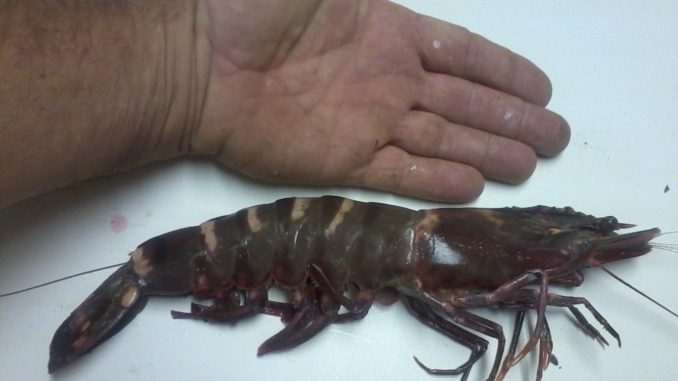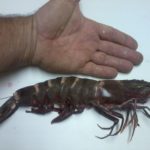
New shrimp shows up out of the blue
Louisiana is a shrimp-crazy state. Until being battered by cheaper imports, shrimp fisheries were the backbone of the economies of many coastal communities. The value of the fishery dwarfed the others.
Recreational fishermen set their speckled trout fishing clocks on “when the shrimp come in.” Live and market (dead) shrimp are heavily used as bait by coastal fishermen. The sight of laughing gulls diving wildly on a school of specks and other fish slaughtering an even larger school of shrimp can make even a seasoned angler’s blood run warm.
The brown shrimp of spring and the white shrimp of fall, along with several smaller coastal and offshore species, made up the totality of Louisiana’s marine shrimp population — until now.
Commercial shrimpers from the south Atlantic through the Gulf of Mexico, including Louisiana, are hauling in what may be the newest member of foreign species introduced into U.S. waters, this one a shrimp. And it’s a really big shrimp.
Penaeus monodon, known in popular language as the black tiger shrimp, Asian Tiger shrimp or giant tiger prawn, commonly grows to the size of three to the pound (called “count” in shrimp talk), and sometimes even 2 count or larger. Compare that to the largest white or brown shrimp, which will only rarely grow to 8 to 10 count.
Not only are they big, they are outlandishly colored — black with white to buff-orange stripes playing ring-around-the-body. You couldn’t miss one in a basket of native shrimp.
Black tiger shrimp are no strangers to U.S. shores. For years they have been coming in frozen in 5-pound boxes to be sold in restaurants and seafood stores. While few have made it to Louisiana markets, they have received a welcome with chefs elsewhere. Besides being big, they have a reputation for a mild but excellent taste and a tender, less dense flesh than many other shrimp.
Richie Billington, a South Carolina shrimper who netted quite a few in late fall of 2011, supports the part about them tasting good. He took his catch home and cooked it with garlic salt and butter.
“It tastes like lobster, but not as tough,” he reported. “I’ll tell you what, I like it better (than local shrimp).”
The species was first reported in the wild in this country in 1988, after 2,000 escaped from a mariculture facility in South Carolina. Several hundred were caught later that year by shrimp fishermen in South Carolina, Georgia and Florida.
Then they disappeared for 18 years. Predictions of no problems from the escapees by scientists seemed to be borne out. Black tiger shrimp, they said, could not survive temperatures below 77 degrees. They are a tropical species.
Only one more specimen was reported before 2006, when they suddenly reappeared in small numbers. That year, one was caught near Dauphin Island, Ala., and another was caught off North Carolina. In 2007 one was reported from Louisiana and others were reported from Florida, South Carolina and North Carolina.
Gradually more and more were reported, until the flood gates seemed to open in 2011.
“It’s not whether you have caught one any more,” reported veteran Lafitte shrimper Ronald “Jug” Dufrene. “It’s whether you haven’t caught at least one.
“Everyone is catching them.”
The catches have left biologists puzzled. No more live black tigers have been imported into the United States since the 1988 episode. The species is native to the Indian Ocean and southeast Asia, including Thailand, where its aquaculture was developed.
Its large size (big shrimp are worth more per pound than small shrimp) and ease of culture have resulted in their importation into the Caribbean and South America. Some think that black tigers are likely to have escaped from Caribbean mariculture facilities during floods from hurricanes. Black tigers have also established wild populations in South America.
Could these have been carried to the U.S. by water currents? Others propose that they were discharged in ship ballast. Offering some support to the theories that the animals being caught were spawned elsewhere and carried here is the fact that no small black tigers have been caught. Most have been very large.
Still, the surge in numbers has many scientists using the word “probable” when discussing whether a breeding population exists in this country.
Other than their supposed intolerance for cold water, their life cycle is very similar to that of white and brown shrimp, including their salinity preferences. They are strong spawners, with females producing from 500,000 to 750,000 eggs.
Any exotic species, as non-native creatures are called, causes some concern among scientists and environmentalists. Creatures (and plants) new to an ecosystem can often out-compete natives, mostly because the exotics leave behind the predators and diseases that controlled them in their native land.
Of course, sometimes they bring their diseases with them and the diseases cause as many problems as the creatures themselves. Louisiana’s native red swamp crawfish diseases have virtually wiped out native European crawfish populations, for example.
The Monterey Bay Aquarium in California, the self-appointed arbiter of what seafood environmentally conscious people should and shouldn’t eat, has blackballed black tiger shrimp. They have deemed wild populations to be overfished and farming operations to be of the open-system type, of which they don’t approve.




